Google scientists have explored how AI can be taught to predict the smell of a substance based on its molecular structure. This fundamental problem in the field of digital olfaction has remained unresolved for a long time.

To develop this AI model, researchers harnessed the power of graph neural networks, a specialized form of AI tailored for graph data. The beauty of this approach lies in its ability to represent molecules as graphs, with atoms as vertices and bonds as edges. This unique representation facilitates an effective analysis of molecular features.
The model was meticulously trained using a dataset comprising 5,000 molecules, each paired with corresponding odor descriptors such as “floral” or “fruity.” Following rigorous training, it was put to the test against 400 previously unseen molecules.
The neural network exhibited the ability to describe the smells of unfamiliar substances on par with an average human. What’s more, it outperformed traditional chemical descriptor-based approaches.
This AI-generated “smell map” goes beyond scent description. It can be seamlessly applied to various olfaction-related tasks, such as gauging the similarity of odors between different substances. Consequently, researchers have paved the way for a versatile tool that can unlock the secrets of the olfactory world.
In the future, models like this could upgrade the discovery of new aromas and fragrances. By automatically predicting the smell of yet-to-be-synthesized molecules, these AI systems eliminate the need for costly experimental testing, significantly expediting the innovation of scents and flavors.
Unlike other senses like vision and hearing, olfaction lacks a well-established map that links physical properties to perceptual properties. This POM accurately represents perceptual hierarchies and distances and even outperforms human panelists in odor description. It predicts odor intensity and perceptual similarity, offering a deeper understanding of the world of smell.
Source: mPost



